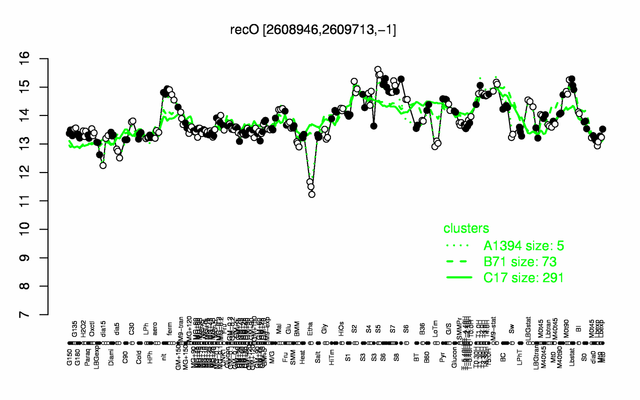Difference between revisions of "RecO"
(→Original publications) |
|||
| Line 151: | Line 151: | ||
<pubmed> 22933559 </pubmed> | <pubmed> 22933559 </pubmed> | ||
== Original publications == | == Original publications == | ||
| − | <pubmed>24891441,18599486, 19730681 20581116 22373918 17581636 21170359 24285298 24285298 25939832 26001966</pubmed> | + | <pubmed>24891441,18599486, 19730681 20581116 22373918 17581636 21170359 24285298 24285298 25939832 26001966 15186413</pubmed> |
[[Category:Protein-coding genes]] | [[Category:Protein-coding genes]] | ||
Revision as of 11:02, 10 August 2015
- Description: mediator of RecA binding to ssDNA, required for the formation of RecA DNA repair centers, , required for efficient survival and replication restart after replication-transcription conflicts
| Gene name | recO |
| Synonyms | yqxN, yqfI |
| Essential | no |
| Product | mediator of RecA binding to ssDNA |
| Function | DNA repair/ recombination |
| Gene expression levels in SubtiExpress: recO | |
| Interactions involving this protein in SubtInteract: RecO | |
| MW, pI | 29 kDa, 8.208 |
| Gene length, protein length | 765 bp, 255 aa |
| Immediate neighbours | glyQ, yqzL |
| Sequences | Protein DNA DNA_with_flanks |
Genetic context 
This image was kindly provided by SubtiList
| |
Expression at a glance PubMed
| |
Contents
Categories containing this gene/protein
This gene is a member of the following regulons
The gene
Basic information
- Locus tag: BSU25280
Phenotypes of a mutant
- drastically reduced survival of mature dormant spores after exposure to ultrahigh vacuum desiccation and ionizing radiation that induce single strand (ss) DNA nicks and double-strand breaks (DSBs) PubMed
- recO recJ double mutants are extremely sensitive against DNA damaging agents PubMed
- recO addA-addB double mutants are extremely sensitive against DNA damaging agents PubMed
Database entries
- BsubCyc: BSU25280
- DBTBS entry: no entry
- SubtiList entry: [1]
Additional information
The protein
Basic information/ Evolution
- Catalyzed reaction/ biological activity:
- provides RecA access to ssDNA during chromosomal transformation (together with DprA) PubMed
- catalyzes annealing of SsbA or SsbA/SsbB coated ssDNAs to allow the formation of DNA duplexes with tails during plasmid transformation PubMed
- required for the formation of RecA DNA repair centers (together with RecR) PubMed
- Protein family: recO family (according to Swiss-Prot)
- Paralogous protein(s):
Extended information on the protein
- Kinetic information:
- Domains:
- Modification:
- Cofactor(s):
- Effectors of protein activity:
- Localization:
- cytoplasm (according to Swiss-Prot)
- localizes to the DNA entry pole during transformation PubMed
Database entries
- BsubCyc: BSU25280
- Structure:
- UniProt: P42095
- KEGG entry: [2]
- E.C. number:
Additional information
Expression and regulation
- Operon:
- Sigma factor:
- Regulation:
- Regulatory mechanism:
- Additional information:
Biological materials
- Expression vector:
- lacZ fusion:
- GFP fusion:
- two-hybrid system:
- Antibody:
Labs working on this gene/protein
Your additional remarks
References
Reviews
Original publications
Begoña Carrasco, Tribhuwan Yadav, Ester Serrano, Juan C Alonso
Bacillus subtilis RecO and SsbA are crucial for RecA-mediated recombinational DNA repair.
Nucleic Acids Res: 2015, 43(12);5984-97
[PubMed:26001966]
[WorldCat.org]
[DOI]
(I p)
Samuel Million-Weaver, Ariana Nakta Samadpour, Houra Merrikh
Replication Restart after Replication-Transcription Conflicts Requires RecA in Bacillus subtilis.
J Bacteriol: 2015, 197(14);2374-82
[PubMed:25939832]
[WorldCat.org]
[DOI]
(I p)
Justin S Lenhart, Eileen R Brandes, Jeremy W Schroeder, Roderick J Sorenson, Hollis D Showalter, Lyle A Simmons
RecO and RecR are necessary for RecA loading in response to DNA damage and replication fork stress.
J Bacteriol: 2014, 196(15);2851-60
[PubMed:24891441]
[WorldCat.org]
[DOI]
(I p)
Ignacija Vlašić, Ramona Mertens, Elena M Seco, Begoña Carrasco, Silvia Ayora, Günther Reitz, Fabian M Commichau, Juan C Alonso, Ralf Moeller
Bacillus subtilis RecA and its accessory factors, RecF, RecO, RecR and RecX, are required for spore resistance to DNA double-strand break.
Nucleic Acids Res: 2014, 42(4);2295-307
[PubMed:24285298]
[WorldCat.org]
[DOI]
(I p)
Tribhuwan Yadav, Begoña Carrasco, Angela R Myers, Nicholas P George, James L Keck, Juan C Alonso
Genetic recombination in Bacillus subtilis: a division of labor between two single-strand DNA-binding proteins.
Nucleic Acids Res: 2012, 40(12);5546-59
[PubMed:22373918]
[WorldCat.org]
[DOI]
(I p)
Audrey Costes, François Lecointe, Stephen McGovern, Sophie Quevillon-Cheruel, Patrice Polard
The C-terminal domain of the bacterial SSB protein acts as a DNA maintenance hub at active chromosome replication forks.
PLoS Genet: 2010, 6(12);e1001238
[PubMed:21170359]
[WorldCat.org]
[DOI]
(I e)
Candela Manfredi, Yuki Suzuki, Tribhuwan Yadav, Kunio Takeyasu, Juan C Alonso
RecO-mediated DNA homology search and annealing is facilitated by SsbA.
Nucleic Acids Res: 2010, 38(20);6920-9
[PubMed:20581116]
[WorldCat.org]
[DOI]
(I p)
Dawit Kidane, Begoña Carrasco, Candela Manfredi, Katharina Rothmaier, Silvia Ayora, Serkalem Tadesse, Juan C Alonso, Peter L Graumann
Evidence for different pathways during horizontal gene transfer in competent Bacillus subtilis cells.
PLoS Genet: 2009, 5(9);e1000630
[PubMed:19730681]
[WorldCat.org]
[DOI]
(I p)
Candela Manfredi, Begoña Carrasco, Silvia Ayora, Juan C Alonso
Bacillus subtilis RecO nucleates RecA onto SsbA-coated single-stranded DNA.
J Biol Chem: 2008, 283(36);24837-47
[PubMed:18599486]
[WorldCat.org]
[DOI]
(P p)
Joanna Timmins, Ingar Leiros, Sean McSweeney
Crystal structure and mutational study of RecOR provide insight into its mode of DNA binding.
EMBO J: 2007, 26(13);3260-71
[PubMed:17581636]
[WorldCat.org]
[DOI]
(P p)
Dawit Kidane, Humberto Sanchez, Juan C Alonso, Peter L Graumann
Visualization of DNA double-strand break repair in live bacteria reveals dynamic recruitment of Bacillus subtilis RecF, RecO and RecN proteins to distinct sites on the nucleoids.
Mol Microbiol: 2004, 52(6);1627-39
[PubMed:15186413]
[WorldCat.org]
[DOI]
(P p)